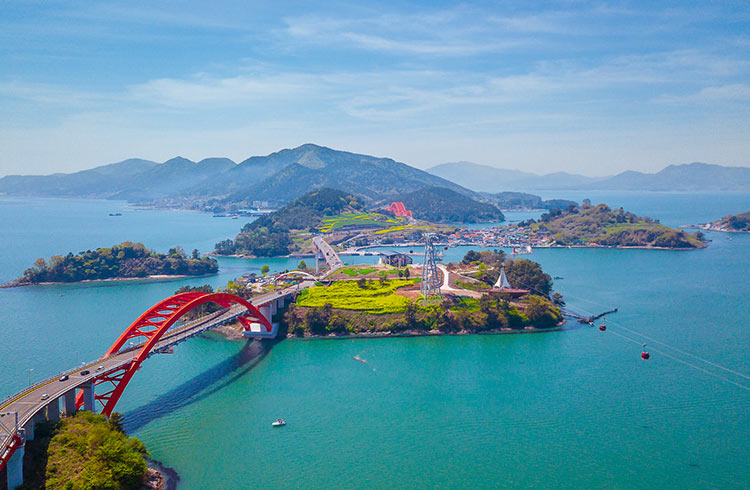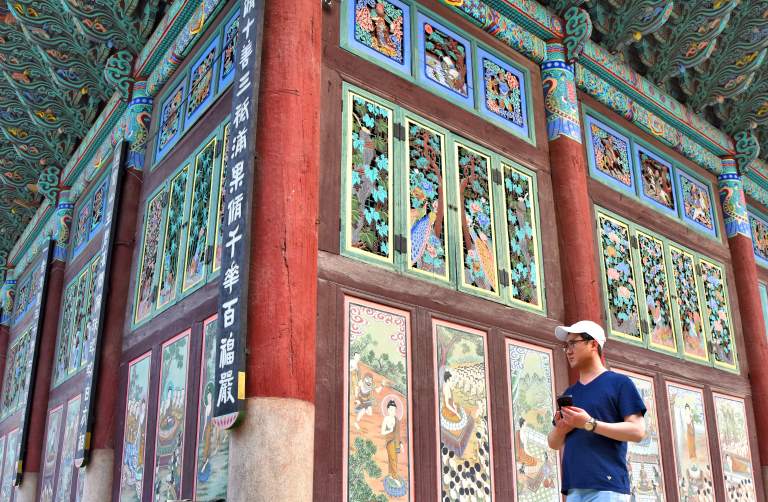Transport in South Korea: How to Get Around Safely
Coronavirus (COVID-19) and travel: The situation around the world is changing dramatically. Various governments have changed their travel warnings to restrict travel during this time. To understand how this may impact cover under your policy, please go to our FAQs and select your country of residence.
For the latest travel warnings and alerts around the world, read about lockdowns and border restrictions.
Bus, train, car, taxi and ferry – South Korea has plenty of transport choices to get you around. We look at what options you can use to see South Korea safely.
Shares
 Photo © Getty Images/Panwasin Seemala / EyeEm
Photo © Getty Images/Panwasin Seemala / EyeEm
- Driving in South Korea
- Motorcycle and pedestrian accidents in South Korea
- Taxi tips for South Korea
- T-Money: South Korea's transport card
- South Korea's trains
- South Korea's buses
- Inter-island ferries in South Korea
Driving in South Korea
The traffic in South Korea is very similar to many other larger countries such as the United States. However, the difference is that South Korea is one of the most urbanized countries on the globe, with a huge population density and several huge cities to think about. This makes the roads some of the most dangerous in the world, with high rates of traffic deaths. Pedestrian deaths make up a huge portion of this, so be aware of the rules of the road when walking around in South Korea.
Traffic signals are a courtesy at best and a tactical psyche-out at worst, as some drivers will literally do anything to ensure that they get to where they're going faster than anyone else.
The most dangerous part of South Korean roads are the streets of downtown neighborhoods. The main streets that people drive on to get between areas are similar to driving between neighborhoods back home, but the streets that link all the shops and restaurants in downtown neighborhoods are not limited to traffic laws.
So when walking around, keep watch for vehicles as they may sometimes move fast through crowds. This generally happens in isolated areas where there is no sidewalk. It’s likely where you will be on a Saturday night, but not a widespread problem across town.
People in the cities of South Korea navigate dozens of streets every day without getting killed and after you've stayed in the country for a few days, you'll start to get the hang of it and develop an instinct for what will work and what won't, but until then it may feel as though you're entrusting your life to a city you don't even know.
Motorcycle and pedestrian accidents in South Korea
If you saw a motorcycle cruising down a footpath in, say, New York City, you'd wonder if someone was shooting a high-stakes chase scene for a Hollywood movie. Back home, we're often upset when a cyclist zooms up behind us on the sidewalk.
However, in South Korean cities it's common for motorcyclists to attempt to bypass traffic by sharing footpaths with pedestrians. This had led to a number of injuries and deaths, though it is surprisingly less than you might think.
Nobody is going to look out for you, so make sure you only step into a crosswalk when you're absolutely sure it's safe. If cars are stopped all around and the walk signal is green, you can start to walk.
A good way to figure out what to do at an intersection when you're not sure when it's safe, is to simply follow everyone else's lead. Cars are more likely to stop for a large group of people, and locals are much more likely to know when it's safe to cross and when it isn't.
In general, walk on the side furthest from the road, as motorcycles will weave onto and off of the sidewalk from the road. If you hear an engine rev disturbingly close to you, move away from the road.
Traffic in South Korea may seem like another planet, and it may be alarming when you first step off the airplane. There's nothing you can do about it except to be informed and become aware of the difficulties. If you are sensitive to your surroundings, give yourself some time to get used to the rhythms of the city before walking out on your own.
Taxi tips for South Korea
Legitimate taxi drivers are generally among the most skilled of the drivers in South Korea, though it may not feel that way. Although if you get carsick easily, consider taking public transport where you need to go.
Only use licensed, marked taxis if you do choose to go that route. Unmarked taxicabs often frequent the airport. Initially, fares are calculated on the meter by distance but will switch to time if you get stuck in a bit of traffic. Tipping is not expected.
There are several types of licensed taxis:
- Standard Taxis (ilban) - Which are generally orange in Seoul but also can be silver and while. These are the cheapest taxi and commonly found in most neighborhoods, making them easy to flag down. Their base fare is generally 2800 - 3300 KRW (US $2.60 – $3)
- Deluxe or Model Taxis (mobeom) - These are black with a yellow sign on top. Their flag fare rates can be higher but they don't have late night surcharges. Deluxe taxis are also larger luxurious cars which tend to be found around hotels and major tourist areas. Their base fare is generally 3200 - 5500 KRW (US $3 – 5)
- International Taxis - These are orange and have "international taxi" on the outside of the vehicle. They are slightly more in price than a standard taxi and are driven by drivers who are proficient in languages such as English, Chinese, Japanese or a combination of.
There is a reasonable chance your driver may not speak English, but don't worry! One option is to write down your destination on a piece of paper to hand to them. South Korea Tourism also has a tourist hotline which is open 24/7 and can help with interpreting if you need it between you and your driver. You can call them on 1330.
T-Money: South Korea's transport card
Like many countries, South Korea has a transport card, making it an easy way to use the public transport network so you can see the sights without the need to fumble for change. T-Money is a touch 'n' go, rechargeable card which can be used with trains, subways, taxis, and buses.
Some vending machines will also let you use your T-Money card to purchase items.
The cards are found at convenience stores or subway stations; where you can purchase one for as little as for 2500 - 4000 KRW (US $2 – 4).
Catching a train in South Korea
Trains are a great way to get around and in between cities without the hassle of being stuck in traffic. South Korea's subway system is efficient, cheap, safe and clean; music to any traveler's ears and with the added bonus of signage in both English and Korean.
Six major cities have their own subway system: Seoul, Busan, Daejeon, Daegu, Gwangju, and Incheon. It's a good idea to avoid rush hour in the morning and afternoon if you can unless you don't mind your personal space being invaded.
Seoul's Incheon Airport has a train service, AREX which is a cheap and fast way to get from the airport into the main city center. It takes around 43 minutes one way and is approximately 4150 – 8800 KRW (US $4 – 8) depending which service you take. There are two services available for the AREX: An all stations commuter service which stops at 13 locations on the way to Seoul and the Express service which runs straight from the airport to Seoul.
South Korea's buses
Buses service all corners of South Korea and there is a service for everyone. They leave frequently between major cities and towns, with hourly services to more outer urban areas and rural locations. The buses in the urban centers don't tend to stick to a timetable as they are at the mercy of the traffic however they do have onboard staff so you can make sure you're taking the bus to the right destination and avoid the risk of accidentally boarding the wrong one. Thankfully, the expressways around major cities have a bus lane, reducing the chance of being stuck in traffic and wasting your day away.
The buses also do not have toilets onboard so use the bathroom before boarding. Long journeys will have rest stops thankfully so you don't have to be preoccupied with that desperate need for the toilet the entire ride.
Top tip: Buy your ticket in advance if you plan to travel on the weekends or holiday periods. Saves the drama of lining up in the crowds and ensures you have a seat.
Inter-island ferries in South Korea
South Korea has two ferry networks: domestic and international. The international ferries travel to China, Japan, and Russia, each leaving from different ports. If you're not in a hurry to get to a destination, or would like a more scenic way of traveling, this could be an option for you. A ferry from Busan to Fukuoka, Japan can take as little as two hours one way, whereas if you plan to hit up Vladivostok in Russia, it will take you 16 hours from Donghae.
Domestically, there are hundreds of ferries servicing islands off the South Korean mainland including the popular volcanic island of Jeju. Jeju-Do is a UNESCO World Heritage site, global geopark and biosphere reserve; with around 9 million people visiting it for its beautiful scenery, relaxation and outdoor activities such as hiking, swimming, and scuba diving.
Island hopping is also a great way to take a day trip from the mainland plus experience the authentic culture of South Korea.
Get a travel insurance quote for South Korea
You can buy at home or while traveling, and claim online from anywhere in the world. With 150+ adventure activities covered and 24/7 emergency assistance.
Related articles
Simple and flexible travel insurance
You can buy at home or while traveling, and claim online from anywhere in the world. With 150+ adventure activities covered and 24/7 emergency assistance.
Get a quote
1 Comment
Thanks for the informative post! We've learnt alot from what you wrote before our trip to Korea! Hope our guide to <a href="http://2bearbear.com/the-ultimate-guide-to-driving-in-south-korea/">driving in South Korea</a> can also help other travelers driving in South Korea in future!
Happy Travels Everyone!
Tom & Kate,
2bearbear.com